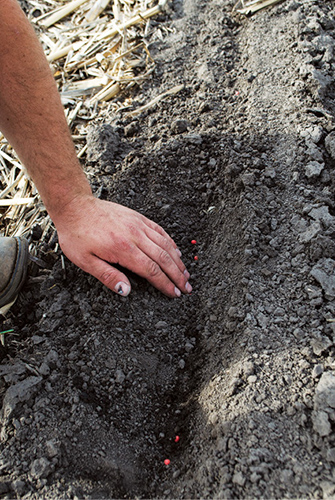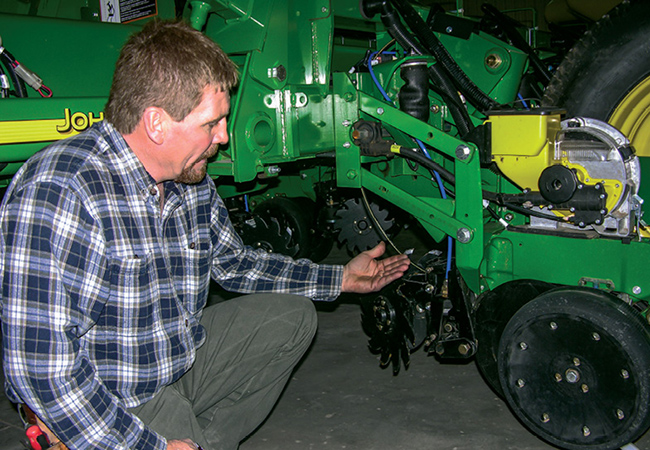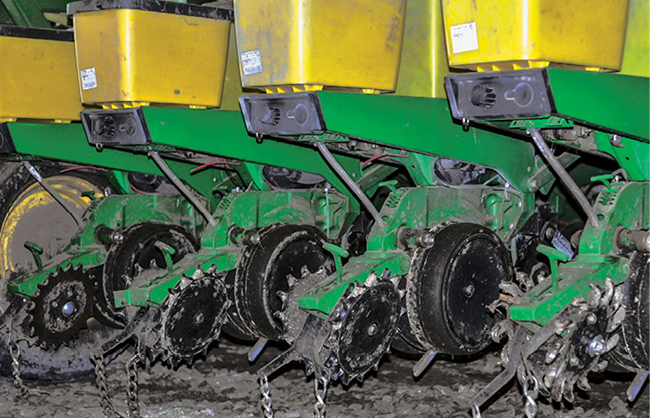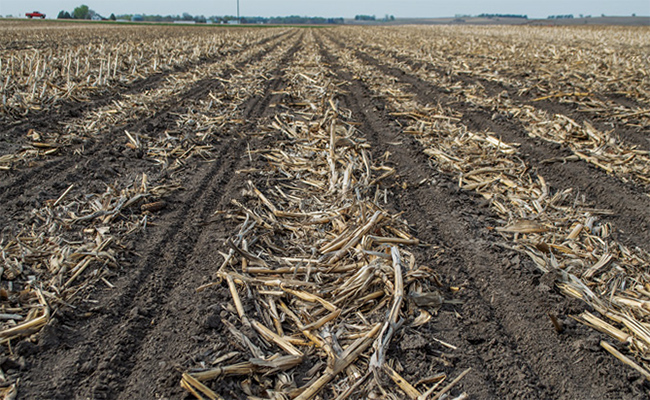PLANTING PROFICIENCY. Strip-till can create an ideal seedbed, but an effective planting strategy starts with down pressure monitoring, seed depth control and residue management.
In any farming practice, the cornerstone of growing a profitable crop is an effective planting strategy.
But strip-till often requires more attention to detail because farmers only have several inches of optimal planting space to work with. Hitting — or missing — that target zone can be the difference between a bumper crop and disappointing yields.
“One thing I love about strip-till is that it provides the most consistent planting condition of all tillage systems,” says Andy Thompson, an Illinois strip-tiller and regional sales manager with Yetter Mfg. “But we’ve witnessed farmers struggle with strip-till when they don’t put the proper time and effort into getting their planter ready to take full advantage of those ideal conditions.”
Both strip-tillers and equipment manufacturers say certain factors — including downpressure, seed depth control, residue management and seed trench closure — are critical to planting a profitable crop in strip-till.
Clearing The Strip
Strip-till rigs often serve as primary residue managers, but that doesn’t mean farmers can take a casual approach with their planter to keep strips clean, Thompson says. Ideally, farmers should have planter lift wheels riding on the residue, and the row units on the clean strip, to ensure the best planting conditions.
“If a farmer makes poor strips and comes out to plant into them with residue mixed in, there’s no magic fix with row cleaners or the planter that is going to compensate for that,” Thompson says. “This can lead to poor seed-to-soil contact and emergence. Paddle or spiked closing wheels and residue managers are very important on the planter to ensure we get every seed emerged evenly and as quickly as possible, but there’s also no way to trump Mother Nature.”

DEPTH OF KNOWLEDGE. Consistent planting depth in the strip can promote early season emergence. In 2014, Nebraska strip-tillers Ray and Kevin Kucera saw a 2-5 bushel per acre bump in strip-tilled soybeans over no-till planting at 1½ inch depths, instead of 1-2 inches.
Thompson farms with Niota, Ill., strip-tiller Kevin Schmitz, and his son, Brent, and helped set up their Kinze planter for better residue management on 800 acres of strip-tilled corn. The soil on top of their strips this past spring was particularly hard, and the rigid residue managers mounted on no-till coulters that were previously on their planter were making the row unit hop. Erratic seed placement was a concern.
To compensate for the harder soil, they added Yetter’s Air Adjust Residue Manager system, which provided more flexibility to adjust downpressure on the row cleaners from the tractor cab.
“We made sure our residue managers were clearing those clods and leveling off those strips,” Thompson says. “We didn’t create a big divot, but we made a smoother strip for the row unit and closed the seed trench with a paddle wheel.”
Thompson says they harvested some of their best corn yields ever last fall, with some fields pushing 260 bushels per acre. While several factors contributed to the bumper crop, Thompson says smoothing out the ride of the planter and adding floating residue managers helped with consistent seed placement while the paddle closing wheels gave them consistent seed-to-soil contact.
Clear It Up
Clearing residue off the strip also sets the stage for good seed-to-soil contact in a strip-till environment, experts say. Proper closure of the seed trench is an objective in any tillage system, but in no-till, or strip-till there are additional variables to contend with, which can make this objective more difficult, Thompson says.
“Identifying inadequacies is important on each farm and then being able to address and fix those issues are where many people fall short of reaching these goals 100% of the time,” he says.
Fort Dodge, Iowa, strip-tiller Dave Nelson says his primary goal is ensuring a smooth ride for the planter row unit across the strip.
Nelson runs a 32-row John Deere planter with Yetter floating residue managers and Precision Planting’s CleanSweep downpressure adjustment system. They are valuable tools for clearing excess residue that can accumulate, but they also smooth out the strips he makes with his 12-row Blu-Jet strip-till unit the prior fall, Nelson says.

CUSHION THE BLOW. Nebraska strip-tiller Jerry Baysinger closely regulates down pressure on his 24-row John Deere 1770 planter, equipped with Yetter’s Air Adjust floating row cleaners and Precision Planting’s AirForce pneumatic down pressure system, to avoid erratic seed placement in mellow soil conditions.
“You can smack that clump of soil with your finger — and that’s what you need that row unit to do — to give you that smooth strip,” he says. “The first time I strip-tilled, I remember in the fall it was a little clumpy and I thought, ‘This is my seedbed, I have to do a better job.’
“To protect and manage that ideal seedbed I’ve created in strip-till, I want to be very specific with the settings on my planter. Being able to adjust those settings from the cab is a big benefit, because I’m less likely to get out of the tractor and make those slight pin adjustments manually.”
‘Planting on a Pillow’
For Nelson, a key component to improving planter ride and seed-to-soil contact on different field conditions is managing downpressure on row units.
“I know when we go from strip-till to no-till, I have to adjust my depth because the strip is such a mellow seed bed,” he says. “It’s like planting on a pillow vs. the harder ground I encounter with no-till.”
Nelson uses Precision Planting’s DeltaForce system, which allows for downpressure control on individual rows through the manufacturer’s 20/20 SeedSense monitor. He says the system keeps his planter row units firm against the strip and provides consistent seed depth.
“The even stands, and seeing all the plants coming up at the same, is what we aim for,” Nelson says. “That’s been the biggest benefit of precisely controlling our downpressure in strip-till.”
While most strip-tillers rely on RTK-level guidance to set and transfer A-B lines in the field, that accuracy is only as good as the placement of the seed in the strip.
As Sean Arians, marketing manager with Precision Planting notes, the objective of strip-till is to create the most ideal planting conditions.
“With strip-till, you generally have a very soft pass where your row unit is not going to require as much downforce as you may need with conventional tillage, because you have that ‘grandma’s garden’ soil type you are planting into,” he says. “If you get off of the row and you’re in hard soil, you’re going to lose the depth of that seed. And once you change the seed depth, you start to create emergence problems and that will affect yield.”
This is something Bruning, Neb., strip-tiller Jerry Baysinger keeps in mind, especially when enduring an unpredictable freeze-thaw cycle that can rapidly change planting conditions.
Baysinger strip-tills about 3,000 acres of corn and soybeans with a custom, 12-row toolbar and an older version of Yetter’s High-Residue Maverick row units.
He prefers to build strips in late fall, or even early winter, and wants at least a 2-week buffer before planting to reduce any potential burn from anhydrous ammonia application.
But the last several springs have produced inconsistent planting conditions and challenged Baysinger to closely regulate downpressure on his 24-row John Deere 1770 planter, equipped with Yetter’s Air Adjust floating row cleaners and Precision Planting’s AirForce pneumatic downpressure system.
“Controlling the depth of the row cleaners can be tough with a 24-row planter,” he says. “I’d have to get out and adjust every row cleaner individually, so for us, it’s really important to have an adjustable or floating row cleaner on a strip so we don’t throw soil out and create a valley.”
After a bitterly cold winter in 2013, and rapid spring thaw, Baysinger says his fall-built strips were exceptionally soft because they didn’t receive much moisture ahead of planting to settle the strips.
“We had a very deep freeze, so everything heaved up and we were planting on marshmallows,” he says. “Our row units had a tendency to sink down on the strip, so having Air Adjust on the row cleaner allowed us to constantly be moving that downpressure up or down according to the strip conditions.”
Baysinger says the mellower planting conditions required less downpressure than usual on the row units and regulating it improved seed-to-soil contact and early-season emergence.
“We have Air Adjust air bags on our planters, so we took our downpressure down to as low as 35 pounds per row on some of our fields,” he says. “The more downpressure we had, the further down that row unit sunk in that strip and made a divot. By lowering that downpressure, the soil didn’t run down and blow our seed out when we did get a nice rain.”
Controlling Consistency
As some manufacturers move toward designing faster planters, experts still maintain that speed is secondary to planting accuracy.
“It’s safe to say the metering capacity is there to manage the populations strip-tillers want at higher speeds,” says Phil Jennings, service manager with Kinze Mfg. “The biggest concern is maintaining consistent depth and seed spacing. Strip-till provides that uniform seed bed, so the row units should be traveling smoothly across the field.”
One thing Jennings has seen in the field while planting into strips is soil buildup on gauge wheel tires picking up some moist soil from the strip.
“For some fall-built strips, there might be some stale dirt on top of that finely tilled soil below, which holds the moisture,” Jennings says. “In certain conditions, operators should watch the row unit gauge wheels and make sure they are not building up with dirt and reducing set planting depth.”
Consistency in soil structure is critical when planting into strips, notes Kevin Kimberley, owner of Kimberley Ag Consulting in Maxwell, Iowa.
Last spring, while doing a planter evaluation in a farmer’s field, he noticed a pattern of shallow, misplaced corn seeds and saw the gauge wheels on the planter kicking up dirt from the row. Kimberley went in for a closer look and found that the walls of the row were fractured and raised.
“The gauge wheels were running over all the residue going up and down, causing that sidewall lift, which can have a huge impact on emergence,” Kimberley says. “In strip-till, you need more downpressure on those wheels because they aren’t riding on soft ground — it’s firm — and it’s one of the things we see missed the most by farmers.”

WHEELS OF FORTUNE. Illinois strip-tiller Mike Bland experimented with a variety of different closing wheels on his 24-row John Deere planter to determine the best fit for planting in wetter, clay soils. He ended up using Martin Dimple closing wheels because they created a nice, loose seedbed.
One of the best practices for strip-tillers to do in the spring is to take a spade and cut a slot to examine the soil profile and check for sidewall lift. Kimberley says that soil profile should be together without any gaps or fractures.
“I’ve seen a lot of farmers get carried away with their berms, but it should be almost flat in spring, because if it’s raised, that means you’ll probably blow more dirt out,” he says. “But once you know what you’re looking for, it can be corrected.”
Cedar Bluffs, Neb., strip-tiller Ray Kucera and his son, Kevin, want to see fall-built strips about 1-inch above their soil in spring. They strip-till about 1,300 acres of corn and 700 acres of soybeans with a 12-row Strip Cat knife rig made by Twin Diamond Industries.
The desire for more consistent yields drove the Kuceras to switch from no-tilled soybeans to strip-tilled in 2013. A challenge they often faced with no-till was getting good seed-to-soil contact through corn residue.
“We’d sometimes end up with soybeans on top of the ground or under a mound of residue, where they wouldn’t get much sunlight,” Kevin says. “Neighboring seeds might be an inch tall, while others would struggle to emerge through the residue and that would lead to inconsistent stands and yields.”
While a fall strip-till pass helps clear the rows, the Kuceras’ fields are susceptible to residue blowing back on the strips during winter. They outfitted their 18-row John Deere planter with Yetter spike wheel row cleaners and Copperhead Ag Furrow Cruiser closing wheels, which have improved seed-to-soil contact and allowed the Kuceras to plant soybeans slightly deeper than in the past.
“We’re going about 1½ inches deep, compared to about 1-2 inches with no-till,” Ray says. “Our goal is that the consistent depth placement is going to give us the most yield consistency because there won’t be a layer of residue to break through, but still enough moisture in the strip.”
Early returns were positive, with the Kuceras seeing better early emergence of soybean plants last spring and a 2-5 bushel per acre bump at harvest.
“We had more even emergence and plant growth early on, which gave more time for the nodes to get established,” Ray says. “That certainly contributed to the yield increase and planting was a lot easier.”
Work in Progress
Finding the right setup for the planter in strip-till is often an evolution.
Frankton, Ind., farmer Mike Shuter and his sons Brian and Patrick, have progressively modified the setup on their 24-row John Deere 1770NT planter to better handle strip-tilled corn-on-corn residue.
The Shuters strip-till about 2,500 acres of corn using a 60-foot custom toolbar built by Misenhelder Welding, based in Ithaca, Mich., with 24 Orthman Mfg. row units.
On their planter, they had used Martin fertilizer openers behind the floating row cleaner, but after a few years had problems with plugging.
In 2013, they switched to Yetter single-disc fertilizer openers behind the row units by extending the closing setup back 8 inches, and then used Martin floating row cleaners up front with treader wheels to prevent trenching, followed by Martin spiked closing wheels and a drag chain in back.
“This gave us a better system in varied conditions and cleaned off that stalk residue that may have floated over the strip in winter,” Shuter says. “The less residue we have in that seed trench, the better off we are.”
The first year with the system, they averaged 198 bushels per acre on their strip-tilled corn-on-corn acres, compared to about 171 bushels per acre on strip-tilled corn acres planted into soybean stubble.
Shuter admits additional factors contributed to the yield differential, but their corn-on-corn acres came out ahead again in 2014. However, overall corn yields were lower, and Shuter plans to refine his planter setup for strip-till in 2015.
“We had some issues with planter depth control, which I think cost us quite a bit of yield,” he says. “I think there’s some improvements we can make that will give us better emergence in the future.”
Shuter was satisfied with the performance of the Martin row cleaners, but plans on replacing the spiked closing wheels with Dawn Equipment’s Gaugetine closing wheels with the intent of getting a firmer seed bed. He’s also removing the Yetter fertilizer openers and replacing them with a Totally Tubular system to apply fertilizer behind the closing wheels.
“We want to try not having anything application-wise engage the soil, which we thought might have impacted depth control,” he says. “The Totally Tubular system just kind of hangs off the back of the row unit and we’re looking to pull a 1,500-2,000 gallon tank behind the planter.”
Shuter is also switching from Precision Planting’s 20/20 AirForce downpressure system to Ag Leader’s Hydraulic Down Force setup to integrate with their Integra monitor in the planter tractor. Last spring, he says they struggled getting the downpressure system to function properly.
“It cost us the first day of planting and we ended up having to replace some wiring and a module,” Shuter says. “I’m hoping the new system will be a little more reactive.”
Planting Flexibility
Another benefit of strip-till is that there is less pressure on the planter to be a primary source of fertilizer application or residue management. This can allow for more flexibility and experimentation with planter row-unit setups and fertilizer placement.

CLEAN SWEEP. Clearing residue off the strip starts with the strip-till rig, but floating residue managers on the planter are commonly used tools to prepare seedbeds, especially into corn residue.
Fox Lake, Wis., farmer Jonathan Gibbs strip-tills about 525 acres of corn in spring, including 100 acres of corn-on-corn ground. For corn planting, he uses an 8-row Hiniker machine with Rawson coulters. The planter was originally built for ridge-till, but he modified the row units when he made the move to strip-till 5 years ago.
“We’re running a triple-coulter setup in the front,” Gibbs says. “We were using one of the Rawson coulters for 2-by-2-inch fertilizer placement, but one of the disadvantages was that the cornstalks would get trapped behind the tine, causing the coulter to plug.”
He removed the fertilizer tine and switched the row cleaners out for a Sunco Nutri Mate 3 system with the company’s row cleaners. He also added Totally Tubular steel tubes to place the fertilizer underneath the seed. The modifications improved fertilizer placement, ensuring the nutrients are placed below the ground, and he uses the row cleaners to skim off any corn residue or rocks left on the strip, providing a clean seed bed.
With the planter, Gibbs applies 4- 5 gallons of ammonium phosphate (10-34-0) with zinc and Ascend plant growth regulator. The balance of urea is sidedressed when corn is a foot tall and before canopy, mixed with Agrotain nitrogen stabilizer.
“We have a busy planter,” Gibbs says. “But if we end up strip-tilling a couple weeks ahead of planting, we’ve had our ground seal back up.
“So it’s nice to be able to drop those Rawson coulters back in the ground to loosen the strip right in front of our planter unit.”
In 2013, Bethany, Ill., strip-tiller Mike Bland outfitted the row units on his 24-row John Deere 1770 planter with a variety of different closing wheels to determine the best fit for planting in his wetter clay soils. He typically builds strips the previous fall with a 12-row Redball machine.
Among the systems he tried were Case IH’s press wheels, Copperhead Ag’s Furrow Cruisers, Martin Dimple closing wheels and Dawn Equipment’s Curvetine closing wheels. Bland says they all performed well in ideal planting conditions, but differently in muddier fields with heavier residue.
“With some of the systems, the mud and residue tended to wrap around the wheels and get packed and plug,” he says. “We ended up going with the Martin system this spring because it crumbled the sidewall really well, and in muddier conditions left a nice loose seedbed, which is what we want.”
This past fall, Bland harvested 250 bushels per acre of strip-tilled corn in some fields and he attributes the success to a strategic, yet simple approach to planting.
“In strip-till, we know that if we achieve consistent planting depth, we’ll get consistent emergence and, at the end of the day, consistent ear size,” he says. “That all translates to more consistent yields.”







